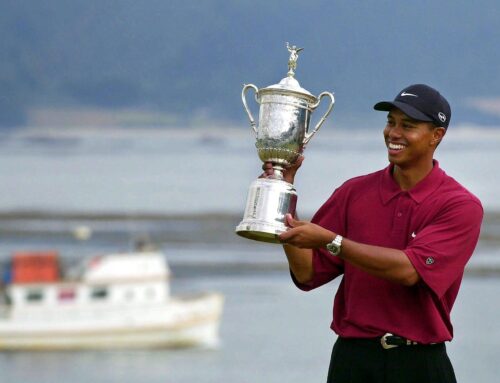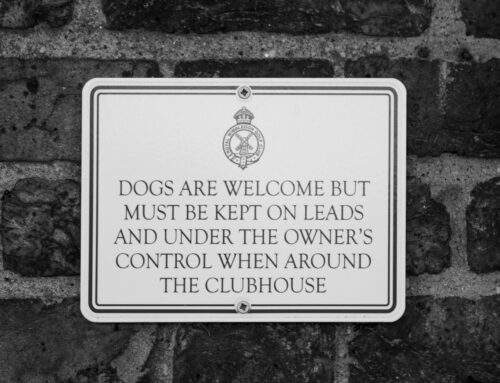
Words by Charlie.
In December of 1857, in Greenock, on the south bank of the River Clyde, a boy was born who would etch his name into the history of Hoylake and who would play a pivotal role in the transporting of the Royal and Ancient game to Asia. His name has understandably been overshadowed by the greats that line the oak-panelled walls at the Royal Liverpool Golf Club, but he was a golfing pioneer, nonetheless. That bonnie lad was Gershom Stewart.
The young Gershom’s stay in Scotland was to be a mere sojourn for he was moved to Merseyside, on the Wirral Peninsula early in his boyhood. It was during this period that he first picked up a set of brass-heads and wandered the linksland around the racecourse at Hoylake. From a young age, he was characterised as a ‘stranger in a foreign land’, a facet, perhaps, of his character which pushed him towards an apprenticeship with the British East India Company in Liverpool. Young Gershom desired to travel. Shortly thereafter, in 1883, he took up a brokerage role at the Hong Kong and Shanghai Bank (HSBC) and set sail with his clubs, via the newly opened Suez Canal, to the Pearl of the Orient: Hong Kong. For the first six years of his stay in Hong Kong, it is likely his hickories were just one of two sets in the entire colony. Alas, they were collecting dust. Amid the bustle of colonial life, and with nowhere to play, Stewart grew restless and could only yearn for a swift round at his beloved Hoylake.
He was known to frequent the racecourse at Happy Valley and hit balls upon turf that was primarily used by the British Military as a parade ground for drills and ceremonies. The land was shared amongst ‘polo, football and hockey interests’ [efn_note] Spencer Robinson, Festina Lente: A History of The Royal Hong Kong Golf Club 1889-1989, (Hong Kong, 1989), p. 3 [/efn_note], and for Gershom, was a nostalgic flashback to the hoof-trodden 1st and 18th fairways of ‘Course’ and ‘Stand’ at Hoylake. After deciding to quit from HSBC, Gershom returned to Hoylake briefly in 1888 before setting up as an independent finance broker in Hong Kong. In May 1889, the wheels started to turn. Gershom had finally whispered his longings for golf in the right ears, notably, the golfing battalion of the Royal and Sutherland Highlanders. Stubborn, he published a notice in the Hong Kong Daily Press that month, stating:
“Gentlemen interested in the Royal and Ancient game of golf are requested to attend a meeting to be held in the Hong Kong Club on Friday 10th May 1889 at 5PM to consider the question of starting a golf links in Hong Kong or Kowloon.” [efn_note] Robinson, Festina Lente, p. 4 [/efn_note]
The meeting, held at the exclusive Hong Kong Club, was attended by 13 distinguished men, notably Robert Murray Rumsey, retired Royal Navy Justice and Sir Thomas Jackson, Chief Manager of HSBC. The attendees voted in favour of the formation of The Hong Kong Golf Club and immediately began to lay out a 9-hole links at the Happy Valley racecourse.
[efn_note] “Layout of 9 hole golf course at Happy Valley Racecourse, Hong Kong”, Illustration, in Robinson, Festina Lente, p. 3 [/efn_note]
The layout, although modest and tightly packed within the boundaries of the racecourse, was emblematic of the era but simply a golfer’s dream. Whilst flat, the newly laid links had great variety, with quaint par 3’s juxtaposed against long par 4’s and carries over water hazards. It was a true golfer’s playground. However, life is sadly never so simple. As the land was still required to be shared with other sports clubs and the military, the quality of the turf paid the price. The infield was also employed by the colonial government as a flood relief and was especially prone to saturation and flooding. Worst of all, however, golf was proving to be so popular with the Hongkongers that the course caught the plight of overcrowding disease.
[efn_note] “Happy Valley Racecourse”, Black and white photograph, (1915) Hong Kong Public Libraries [/efn_note]
The Hong Kong golfers subsequently, after much deliberation and lobbying of the crown, acquired land some 2 miles away at Deep Water Bay. An 8-hole course was laid out so that the Club now had 2 links. In 1897, the story of golf in China returns to Gershom Stewart. By this time, he was good friends, and likely golfing partners, with Hong Kong’s governor, Sir William Robinson. Fortunately, Robinson needed a means by which to celebrate the Diamond Jubilee of Queen Victoria, and thus Gershom Stewart proposed a new road in her name around the entirety of Hong Kong Island and that was connected to the new links at Deep Water Bay. The proposal was enthusiastically approved and rewarded with a Royal Charter from the Queen. In 1897, The Royal Hong Kong Golf Club was born into existence. Sir William Robinson, although a self-confessed ‘hack’, jested of the matter:
“He [Gershom Stewart] made the ‘approach shot’, and I, as it were, ‘holed out the ball’.” [efn_note] Robinson, Festina Lente, p. 11 [/efn_note]
Whilst historians have, of course, noted the colonial and elitist nature of The Royal Hong Kong Golf Club during its early years, enormous credit must be given to Gershom Stewart for carrying the spirit of golf, and indeed the spirit of Hoylake to Asia. Such a feat had only been achieved successfully once prior by Major Hugh Lyon Playfair of St Andrews, who founded the Royal Calcutta Golf Club in 1829. [efn_note] Paul Dimeo, “The Social History of the Royal Calcutta Golf Club 1829-2003” in James H. Mills (ed.) Subaltern Sports: Politics and Sport in South Asia, (London, 2005) [/efn_note] Hong Kong Golf Club has since gone on to host an array of tournaments and seen winners including greats of the game Rory McIlroy, José María Olazábal, Justin Rose and Peter Thomson.
After continued success in finance, Gershom Stewart eventually decided to set sail for the comforts of home upon the Wirral in 1906. He then, almost nonchalantly, proceeded to have an enormously successful career in politics, serving as Conservative MP for the Wirral from 1910-1923 and was made a Knight Commander of the Order of the British Empire (KBE) in 1924.
It was during this period, that Gershom firmly stamped his fingerprint on the game of golf. In 1921, immediately before the Amateur Championship at Hoylake, Gershom, as noted by a contemporary article in The Times, facilitated a match between the visiting Americans and the leading British players of the day. Amongst a host of others, Tommy Armour, Ernest Holderness, Chick Evans, William Clark Fownes Jnr., Bobby Jones and Francis Ouimet came along. The visitors (as they annoyingly often do) won the match 9-3. It was such a success that a match was played again immediately the following year at the National Golf Links of America. This was the first ‘official’ rendition of the Walker Cup. Since that match, 48 iterations have been played, with the USA victorious in 38, the British and Irish in 9 and 1 match with honours even.
[efn_note] “The “Invasion” Begins – American Golfers at Liverpool”, The Times, May 10, 1921. p. 10 [/efn_note]
It is fitting that the Walker Cup, arguably the purest form of matchplay in our game, and our most revered Amateur event was helped on its way by a man who took the game around the world out of his plain love for golf. Not a name known to many, but Gershom Stewart should be remembered as an icon of Hoylake, an embodiment of its convivial spirit and one of the game’s great ambassadors. Above all, however, one must learn from Gershom and his Hoylake/Hong Kong spirit, is that you can always find room for golf.
The Walker Cup returns to St Andrews this year, aptly in the same year as The Open Championship returns to Hoylake.







